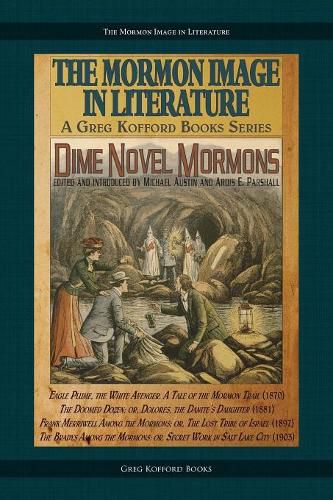Readings Newsletter
Become a Readings Member to make your shopping experience even easier.
Sign in or sign up for free!
You’re not far away from qualifying for FREE standard shipping within Australia
You’ve qualified for FREE standard shipping within Australia
The cart is loading…






Dime novels probably did more than any other kind of book to turn lower- and middle-class Americans into both book owners and book readers. They were so cheap that almost anyone could afford them, and so exciting that almost everybody wanted to read them. It’s hard to tell just how many of these dime novels featured Mormons, but the way Mormons were portrayed in dime novels was remarkably consistent over many decades and multiple genres. This consistency tells us that dime novelists were playing with common stereotypes that nearly all their readers recognized–indeed, these stereotypes worked their way into much of the more respectable literature of the day and influenced the way American culture has interacted with Mormonism ever since. These tropes were based on three things, perhaps the only three things that most Americans knew about the Mormons in the final decades of the nineteenth century: Danites, polygamy, and the Mountain Meadows Massacre. Whatever variation occurs in the dime novels comes from mixing these three ingredients into new concoctions.
For this volume, four full-length dime novels have been chosen to represent different aspects of the Mormon image in dime novels: Eagle Plume, the White Avenger. A Tale of the Mormon Trail (1870); The Doomed Dozen; or Dolores the Danite’s Daughter (1881); Frank Merriwell Among the Mormons; or, The Lost Tribes of Israel (1897); and The Bradys Among the Mormons; or Secret Work in Salt Lake City (1903). The often-lurid and scandalous portrayals of Mormons in these dime novels had consequences for the relationship between Mormons and the rest of the United States. They would represent reality for millions of people, and the basic portrayals found their way into more serious literature. Understanding how these stereotypes were created and first employed can help us understand many things about the way that Mormonism has always functioned in American culture.
$9.00 standard shipping within Australia
FREE standard shipping within Australia for orders over $100.00
Express & International shipping calculated at checkout
Dime novels probably did more than any other kind of book to turn lower- and middle-class Americans into both book owners and book readers. They were so cheap that almost anyone could afford them, and so exciting that almost everybody wanted to read them. It’s hard to tell just how many of these dime novels featured Mormons, but the way Mormons were portrayed in dime novels was remarkably consistent over many decades and multiple genres. This consistency tells us that dime novelists were playing with common stereotypes that nearly all their readers recognized–indeed, these stereotypes worked their way into much of the more respectable literature of the day and influenced the way American culture has interacted with Mormonism ever since. These tropes were based on three things, perhaps the only three things that most Americans knew about the Mormons in the final decades of the nineteenth century: Danites, polygamy, and the Mountain Meadows Massacre. Whatever variation occurs in the dime novels comes from mixing these three ingredients into new concoctions.
For this volume, four full-length dime novels have been chosen to represent different aspects of the Mormon image in dime novels: Eagle Plume, the White Avenger. A Tale of the Mormon Trail (1870); The Doomed Dozen; or Dolores the Danite’s Daughter (1881); Frank Merriwell Among the Mormons; or, The Lost Tribes of Israel (1897); and The Bradys Among the Mormons; or Secret Work in Salt Lake City (1903). The often-lurid and scandalous portrayals of Mormons in these dime novels had consequences for the relationship between Mormons and the rest of the United States. They would represent reality for millions of people, and the basic portrayals found their way into more serious literature. Understanding how these stereotypes were created and first employed can help us understand many things about the way that Mormonism has always functioned in American culture.